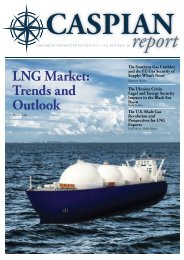Caspian Report - Issue: 07 - Spring 2014
Create successful ePaper yourself
Turn your PDF publications into a flip-book with our unique Google optimized e-Paper software.
Radu Dudau<br />
98<br />
de facto monopolies inside their national<br />
markets. Their terms of delivery<br />
(usually 20-25 years) included<br />
clauses that suddenly became<br />
highly problematic: oil- indexed gas<br />
prices, “take-or-pay” (obligation to<br />
pay at least 85% of annually contracted<br />
volumes regardless of actual<br />
physical delivery), and “destination<br />
clauses” (under which imported gas<br />
cannot be re-exported).<br />
From 2009, the situation for Western<br />
European utility companies was<br />
unsustainable: under pressure from<br />
local distributors securing cheaper<br />
gas from trading hubs, the obligation<br />
to acquire minimal gas volumes<br />
at oil-indexed prices became<br />
unmanageable. As a consequence,<br />
utility companies required and obtained<br />
gradual price reductions and<br />
more flexible contractual clauses<br />
from international suppliers. Some<br />
concessions were reached through<br />
amicable renegotiations, others<br />
through decisions by international<br />
arbitration tribunals.<br />
Taken together, these three tendencies<br />
of the EU natural gas markets<br />
may well be sufficiently transformative<br />
to allow Romania to enjoy diversified<br />
import sources and better<br />
contractual terms.<br />
Import diversification<br />
prospects<br />
99% of Romania’s gas imports come<br />
from the Russian Federation, equal<br />
to about 20% of current total gas<br />
consumption. Nevertheless, these<br />
developing trends offer for the first<br />
time serious prospects for diversified<br />
import sources.<br />
Russian gas from the West<br />
Following the elimination of destination<br />
clauses and the construction<br />
of the Hungarian interconnection,<br />
Romania could import Russian gas<br />
from West to East; in the short to<br />
medium term, the most feasible<br />
options are imports from Austria’s<br />
Central European Gas Hub (CEEGH)<br />
in Baumgarten and der March.<br />
To illustrate the feasibility of this option,<br />
the case of Ukraine case is helpful.<br />
Since 2012, Kiev has been importing<br />
Russian gas from Germany’s<br />
RWE through Poland and Hungary.<br />
To enable larger scale imports, in<br />
December 2013 Eustream (the Slovak<br />
natural gas TSO) agreed to make<br />
arrangements for reverse-flow into<br />
Ukraine via one of its four major<br />
transit pipelines, allowing Kiev to<br />
import up to 10 bcm/year from Germany<br />
– equivalent to more than a<br />
third of the volumes imported from<br />
Russia in 2013. But back then this<br />
arrangement did not come to fruition,<br />
since Russia rewarded ex-president<br />
Yanukovych for turning away<br />
from the EU Association Agreement<br />
with a massive discount on gas<br />
prices, from approximately $400 to<br />
$268.5.<br />
As it is turned out, those improved<br />
price terms were short-lived: the<br />
success of the Euromaidan movement<br />
was followed by the Russian<br />
annexation of Crimea and the onset<br />
of an extremely tense political<br />
standoff between Moscow and Kiev.<br />
Not only was the gas price discount<br />
revoked, but the new price was set<br />
to $480/tcm, one of Europe’s highest.<br />
Under these circumstances, the










